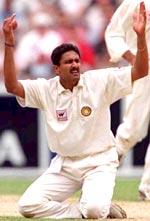Kumble must provide more support
Daniel Laidlaw
Rarely do you have even a remote chance to win Test matches when the
opposition puts up more than half a grand in runs in their first innings.
Fortunately, the first Test in Bloemfontein is developing into a rare
batsman-dominated match that is evolving at such a rate -- match run rate
3.9 -- that an Indian victory seems a little way from the impossibility
that the scores otherwise suggest it should be after three days.
For that to happen, though, the second innings support for Javagal Srinath
would have to undergo serious improvement, or else South Africa will
likely
canter to whatever target is set. It could be argued that India are in no
worse position at the end of day three than they were at stumps on day
two, or are perhaps even better placed, and in that sense the bowlers did a
reasonable job. But given the start India had to the third day, the rest
of it was as equally uninspired as on day two.
 With a day of bowling behind them, it had seemed that all India’s bowlers
had largely corrected their faults. Whereas on day two there was an
absence
of pressure, with no two bowlers able to form an effective partnership for
long and the batsmen allowed to easily rotate the strike, the opposite was
true from the outset of the critical first session. It had to be, as a
continuation of events from the previous day, when South Africa claimed
all
three sessions in an impressive top-order display, could have seen India
batted out of the match.
With a day of bowling behind them, it had seemed that all India’s bowlers
had largely corrected their faults. Whereas on day two there was an
absence
of pressure, with no two bowlers able to form an effective partnership for
long and the batsmen allowed to easily rotate the strike, the opposite was
true from the outset of the critical first session. It had to be, as a
continuation of events from the previous day, when South Africa claimed
all
three sessions in an impressive top-order display, could have seen India
batted out of the match.
The improvement in discipline was evident from the first over from Zaheer
Khan, when he put six balls in the right place outside off. Trying to
affect
a breakthrough with the old ball, Khan was supported by Kumble and
vice-versa, making a significant difference in the pressure applied to
Kallis and a cautious Dippenaar. Gone were the singles borne of an
inconsistent line, as each bowler was allowed to work at one batsman. It
may
not have resulted in the desired early wicket, but it set the pattern for
the session and Ganguly got it just right.
It took half an hour for Dippenaar to score, a measure of the improved
accuracy, and when Khan eventually began to lapse India were able to take
the second new ball with confidence and not desperation, which was what
the
situation had previously been approaching.
India were rewarded for the improvement with Kallis’ wicket. Nehra, who
also
seemed to have benefited from some work, moved the ball just enough
through
the air to be threatening. Kallis's scalp from an induced edge was
immensely
valuable because, as the stats prove, he does not give it away. The first
hour was a perfect example of the best way, without an explosive attack,
to
dislodge a quality batsman on a good wicket. With Srinath seaming the ball
sharply in what was also his best spell, there was a sense that India
could
make further inroads with the new ball.
With an edge behind the wicket being a seam bowler’s most efficient method
of dismissal, most right-handed handed batsmen aren’t used to the ball
consistently seaming into them, which seems to be Srinath’s forte. With
Dippenaar having just driven him through cover and undoubtedly expecting
the
ball to come into him, Srinath instead got one to hold its line and bowled
him comprehensively. It was also evidence of just how he had been hitting
the right length.
Good length from Srinath was in evidence again when Pollock was out
immediately trying to force one that wasn’t full enough. Three wickets in
the session, with South Africa passing India’s total with four wickets in
hand, represented a fine and much-needed comeback.
 It should have demonstrated the approach needed to remove the last four,
but
with Klusener at the crease, India relapsed into day two form. The
intensity
of the first session dissipated all too quickly, as did the scoreboard
pressure, due largely to Lance Klusener. Though chancy against the
seamers,
Klusener batted with a sense of purpose that out-did India’s efforts in
bowling to him. Klusener sensibly hit Kumble fairly straight and nudged
the
ball for runs square, as opposed to hitting across the line in the manner
Kirsten perished.
It should have demonstrated the approach needed to remove the last four,
but
with Klusener at the crease, India relapsed into day two form. The
intensity
of the first session dissipated all too quickly, as did the scoreboard
pressure, due largely to Lance Klusener. Though chancy against the
seamers,
Klusener batted with a sense of purpose that out-did India’s efforts in
bowling to him. Klusener sensibly hit Kumble fairly straight and nudged
the
ball for runs square, as opposed to hitting across the line in the manner
Kirsten perished.
The spread field for Khan and the worthwhile but still desperate move of
introducing Sehwag was a concession that South Africa were again in full,
accumulative command. India needed a frontline bowler to support Srinath’s
effort and logically it should have been Kumble, who was back to being
taken
for easy singles. The damage may not have been inflicted against him on
the
scoreboard as rapidly as when Nehra or Khan were erratic, but given his
role
Kumble was just as ineffective.
Without inconsistent bounce to exploit, Kumble was too easy to milk for
runs
by batsmen without need to be wary, which appeared entirely due to lack of
spin. Even for a leg-spinner reliant more on bounce and subtle variation,
any amount of turn would have made him infinitely more dangerous.
Even on a good pitch, Kumble could have been expected to do more damage
than
3/132 in a workload of 50 overs, of which only 12 were maidens. When he
did
eventually get Klusener caught and bowled, it was significant that the
ball
kicked up out of the rough.
In the absence of Harbhajan Singh, that kind of dismissal could make
Kumble
dangerous in the second innings. Certainly, he needs to step up in support
of Srinath and either create pressure by becoming more restrictive or take
wickets. At the moment, the slow death in ones and twos goes some way
towards explaining his poor away record, and a second innings repeat would
not give India a chance.
More Columns
Mail Daniel Laidlaw